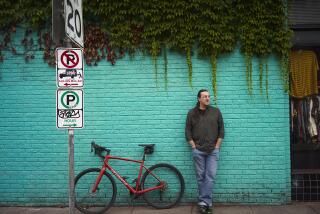Cycles Over the Century : Hundreds Turn Out for S.D. Bike Expo
- Share via
Russ Kennedy’s tricycle went to rust a long, long time ago--long before it was Russ Kennedy’s tricycle, in fact.
It is an “iron tricycle,” circa 1880. The name is derived from the fact that the metal, not the rubber, met the road. Today, one can only assume that a child, circa 1880, loved its lumpy ride and hoped for nothing smoother.
And one can imagine that the original owner might have been a little sad Sunday to see his ancient three-wheeler, displayed with other proud pieces of Kennedy’s cycle collection, receive only passing glances at the “Bicycle and Triathlon Extravaganza” at the San Diego Community Concourse.
Cycling, it seems, has come a long way since metal wheels. One bike shop displayed a sleek machine that captured both the sublime and the ridiculous: a custom-built Masi with a gold-plated frame and a $4,999 price tag. Gold is in, rust is out.
A few hundred cycling enthusiasts, circa 1985, paid $6.50 each to attend the show.
They got to listen to celebrity speakers such as Olympic gold medalist Connie Carpenter and Hawaii triathlon champ John Howard, watch videotapes on cycling tips, and visit about 50 booths marketing everything from club memberships and cycling garb to Gookinaid energy drink and bicycle politics.
A kind of bicycle carrying case was being hyped at one booth. “The Burning Question!” a sign declared. “How Do I Ship My Bike?”
Ten years ago, when people thought of cycling, they might have envisioned a simple cruise around the neighborhood on the old Huffy. Today, the public view might be of people in funny pants humping up a hill, relishing that burning sensation in their thighs.
The fitness movement has helped make cycling a big business that is getting bigger, said Dan Gindling, organizer of the event. “The Olympics didn’t hurt, with nine medals and four golds” for U.S. cyclists, said Gindling, who publishes Bicycling San Diego, a quarterly magazine.
For example, John Howard is probably better known as an author of a fitness book and a champion of the triathlon--the swimming, cycling and running endurance race--than he was as a cyclist, Gindling said. “Back in the ‘70s, he was probably the best known cyclist in the country, which wasn’t saying much,” he said. “But in cycling circles, he was really well known.”
Some cyclists are hoping to transform their growing numbers into clout. Steve Gottlieb manned the booth for the Sierra Club Bicycle Task Force and talked about Assembly Bill 3933, which would provide $4.5 million for bike lanes, bike paths and safety and education programs.
“More than 50% of bicycle injury accidents are caused by bicyclists’ own incompetence . . . And more than 50% of car-bicycle collisions happen when a bicyclist runs a stop sign,” Gottlieb said. “The cyclists’ accident picture could be improved a great deal through proper education.”
On a local level, the Sierra Club Bicycle Task Force is lobbying the Metropolitan Transit Development Board to allow bicycles on the San Diego Trolley on weekends.
Around the corner, Kennedy sat on a folding chair and drank coffee, occasionally talking to the people who were curious about his old bikes. His display included a 1947 Schwinn “Balloon Bomber” with a spring fork shock absorber; an 1886 Windsor ladies’ frame with a kerosene-fired front lamp; an 1886 Columbia high-wheel, so commonplace in its day it was called “an Ordinary”; a 1900 Snell, with a shaft drive instead of a chain; an 1896 Allwood, which indeed had an all-wood frame and rims, and the iron tricycle.
Kennedy, an El Cajon resident and career counselor at Granite Hills High School, said these represented only part of his collection. He said he keeps “15 to 20” bikes in his garage, the number varying because he likes to trade bikes with other collectors in the area.
For Kennedy, bikes are a big hobby, but not big business. He estimated the Allwood--possibly the only one of its kind in existence--to be his most valuable bike. It is worth about $2,000, he said--or $2,999 less than the gold-plated Masi.
“It’s easy to put a thousand hours or so into restoring these old things,” he said. “It took me almost two years, on and off, to restore that old Schwinn.
“There’s no way to make any money at it . . . It’s a labor of love.”
Kennedy waxed poetic over the 1880s and 1890s, when the members of large cycling clubs would take their high-wheels out for tours in the country.
“I have pictures showing people on bicycles in a line that stretches as far as the eye can see,” he said. “The bicycle club was the elite thing, like being in a tennis club today.”
The collector used to ride around with a cycling club, but his interest waned.
“I still like to go out by myself,” he said. “I like to take these old bikes out sometimes and tool around the neighborhood.”


